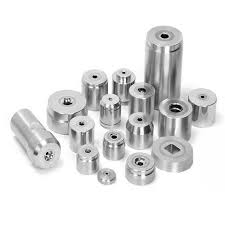Materials: Working with Carbide
GLE-Precision works with many exotic and standard materials to produce precision products for our customers, including carbide, ceramic and steel. This blog discusses working with carbide and how GLE-Precision machines this hard material.
Working with Carbide- How it Begins
Carbide begins as a distributed mixture of tungsten carbide powder (WC) and a small amount of binder powder, which is generally cobalt (Co). The mixture is processed, shaped and sintered. The sintering process liquefies the binder, which when cooled, forms a cement. The hard tungsten carbide powder grains are rigidly imbedded in the cement.
Carbide Grain Sizes
There are several different grain sizes for carbide – submicron, fine, medium, coarse and extra course. The percentage of binder in the carbide has a direct effect on the properties of the finished product. A 3% cobalt binder with a fine grain size has the best wear resistance but is extremely brittle. The Rockwell C for this formula is 80 – 82 with a Transverse Rupture PSI of 225,000 and a Compressive Strength PSI of 660,000. This grade is used for sand blasting nozzles, spray nozzles, drawing dies for soft metals and for wear protection in linings. A 22% cobalt binder with extra course grain size is extremely impact resistant and break resistant but is not as resistant to wear as a lower percentage, finer grain grade. The Rockwell C for this mixture is 60 – 62 with a Transverse Rupture PSI of 350,000 and a Compressive Strength PSI of 480,000. This grade is used in cold and hot forming tools, pressing dies, drawing tools, for fabricating rods, valves and springs, hammer jaws and in shredders for scrap processing. One of the grades that we commonly use is made up of a 6% cobalt binder with a fine grain size. This grade works well for wear protection and machining, milling, drilling and lathing of aluminum, copper, silver, gold, graphite and glass-fiber-reinforced plastics (GFP). The Rockwell C for this formula is 79 – 81 with a Transverse Rupture PSI of 275,000 and a Compressive Strength PSI of 700,000.
Binding Agents when Working with Carbide
Another binding agent commonly used with tungsten carbide is nickel. Nickel grade carbides are extremely corrosion resistant and are generally not attacked by acids, bases, waste water or organic solutions and can be formulated to be non-magnetizable. The Rockwell C for a formula containing 6% nickel with a fine grain size is 78 – 80 with a Transverse Rupture PSI of 275,000 and a Compressive Strength PSI of 690,000. The nickel grade carbide is utilized to make plungers and bushings for pump construction, seals, guides, mixing rods, slide rings, spray nozzles, cutting blades, grinding and mixing systems and in plastics processing. We can work with you to determine the correct grade with the right mix of wear and impact resistance for your application.
How GLE-Precision Works with Carbide
Carbide is used to produce gages, plungers, bushings, dies, pins and mandrels. The precision machinists at GLE-Precision diligently work to meet the customers’ demands when it comes to small parts(ID/OD/OAL: .002” [.0508mm] or less), lapping (.4RA [.01016 micron] or less) and precision tolerances (.000003” [.000076mm] or less).
Please contact us and we can recommend the best material to use for your application. We can be reached at 989-652-6136 or visit our website at www.gle-precision.com.

